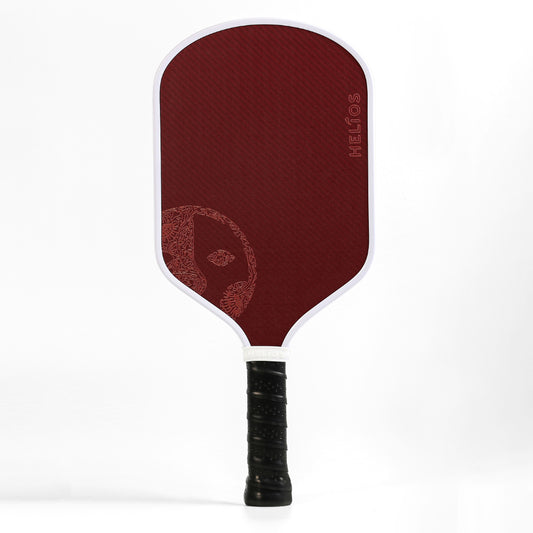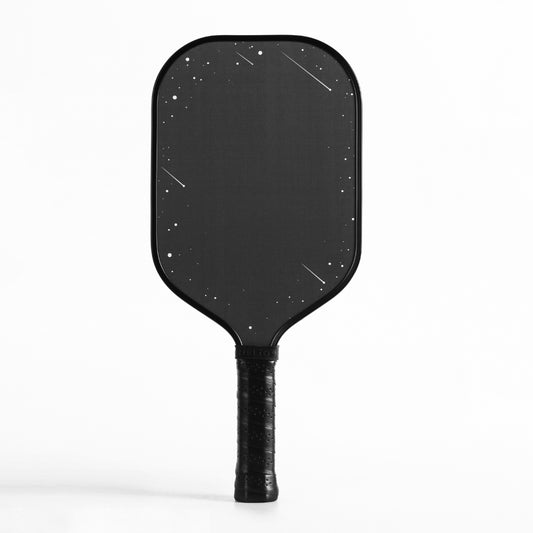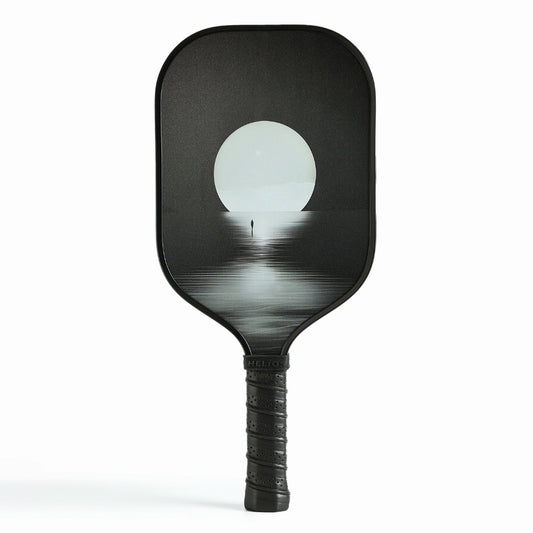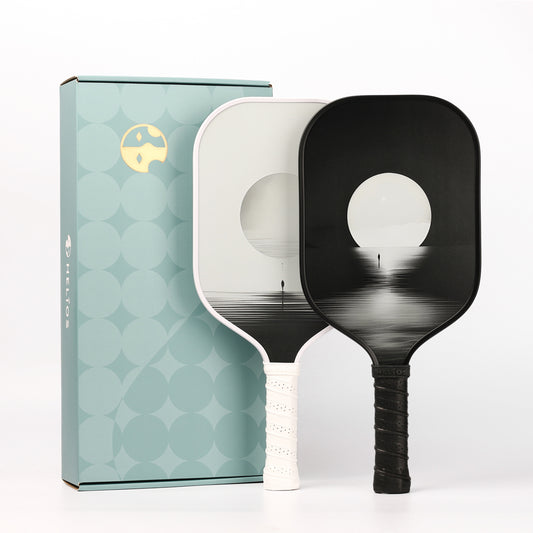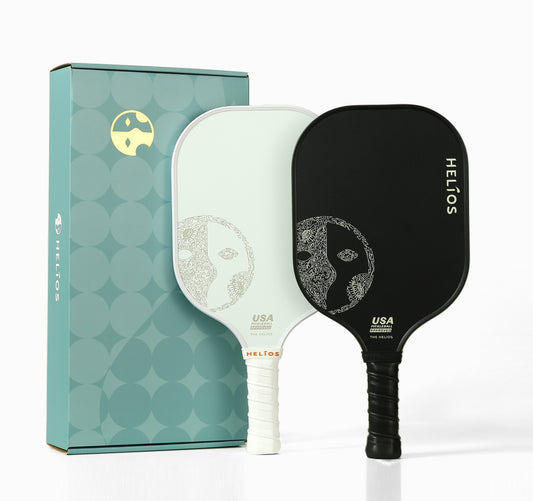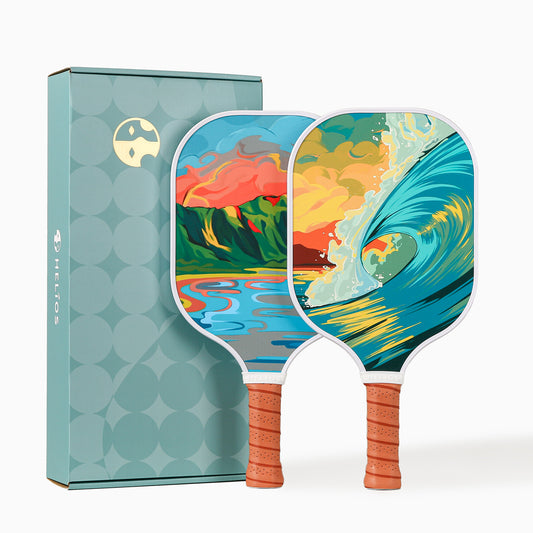Why Top Players Are Switching to EPP — Should You?
Walk onto any competitive pickleball court these days and you'll notice something different. The sharp crack of traditional paddles is being replaced by a distinctive, more controlled sound. Pro players who used to swear by polymer cores are quietly switching to something new. The culprit? EPP foam technology—and if you haven't heard about it yet, you're already behind the curve.
Here's what happened at last month's APP tour event: Ben Johns was spotted warming up with a paddle that sounded... different. Within minutes, a crowd gathered. "What is EPP?" someone asked. Johns just smiled and proceeded to demonstrate shots with a control and power combination that had everyone taking notes. By the end of the tournament, half the pros were asking about EPP foam cores.
So what's driving this mass migration among top players? The answer lies in a foam technology that's been quietly revolutionizing paddle performance. EPP benefits go beyond marketing hype—we're talking about measurable improvements in power transfer, vibration reduction, and paddle longevity that traditional cores simply can't match. Professional players don't switch equipment on a whim. When multiple touring pros abandon paddles they've used for years, something significant is happening.
The question isn't whether EPP technology works—the pros have already answered that. The real question is whether switching to EPP makes sense for your game, your budget, and your playing style. Let's dig into what's really going on with this technology and whether you should join the revolution or stick with what you know.
What is EPP? The Technology Changing Pickleball
Breaking Down the Acronym
EPP stands for Expanded Polypropylene, but knowing that won't help your third shot drop. What matters is understanding how this foam technology fundamentally changes how a paddle performs. Picture thousands of tiny plastic beads that have been expanded with steam—creating a honeycomb of air pockets that work together like a sophisticated suspension system. When done right, you get a core that's 95-98% air yet performs like it's engineered by NASA.
The magic of What is EPP really comes down to its closed-cell structure. Each tiny bead maintains its own sealed air pocket, which means the material doesn't absorb moisture, doesn't break down over time, and maintains consistent performance whether it's your first game or your thousandth. Traditional polymer cores? They start degrading from day one, developing dead spots and losing their pop gradually enough that most players don't notice until it's too late. Similar to how honeycomb pickleball paddles revolutionized core design, EPP takes performance consistency to the next level.
How EPP Cores Actually Work
Here's where EPP benefits become real performance advantages on court. When a pickleball strikes your paddle face, the force travels through to the core. Traditional cores absorb this energy and dissipate much of it as heat and vibration—energy that should be going back into your shot. EPP's unique cellular structure compresses and rebounds with remarkable efficiency, returning more energy to the ball while sending less vibration to your arm.
The numbers tell the story: EPP cores typically provide 25-30% better energy return compared to standard polymer cores. In practical terms? Your drives have more pace with less effort. Your blocks at the net have more "pop." And perhaps most importantly, your arm feels fresher after three hours of play. No wonder players dealing with tennis elbow are often the first converts to EPP technology.
The Manufacturing Difference
Creating an EPP core isn't as simple as pouring foam into a mold. The process requires precise control of temperature, pressure, and timing to achieve the right density and cell structure. Steam expansion must be carefully calibrated—too much and the core becomes mushy, too little and you lose the benefits. Quality manufacturers test each batch for compression strength, rebound characteristics, and consistency across the paddle face.
This complexity explains why not all paddles feature EPP cores. The technology requires specialized equipment and expertise that many manufacturers simply don't have. But companies pushing the envelope, like those producing the FLARE paddle, have invested in the process because the performance gains are undeniable.
Why Top Players Are Making the Switch
Performance Gains That Win Points
Professional pickleball players are creatures of habit. They've spent thousands of hours developing feel with their equipment. So when you see multiple pros switching to EPP paddles mid-season, you know something extraordinary is happening. The performance advantages aren't subtle—they're game-changing.
Take Maria Rodriguez, who made the switch three months ago: "I was skeptical about all the technology talk, but the difference was immediate. My drives have more pace without swinging harder, my resets feel more controlled, and I'm not icing my elbow after every tournament." Her experience mirrors what pros across the tour are discovering—EPP cores provide a unique combination of power and control that traditional materials can't match.
The improved energy transfer means less effort for the same shot quality. During long tournament days, when matches can stretch for hours, this efficiency becomes crucial. Players report maintaining their shot quality deeper into matches, with less degradation in performance as fatigue sets in. That's the difference between winning and losing at the highest levels. Just like how Gen 3 pickleball paddles changed the game with their technology, EPP represents the next evolution.
The Durability Factor
Here's a dirty secret about professional pickleball: pros go through paddles like most of us go through balls. The constant high-intensity play destroys equipment. Traditional polymer cores develop dead spots, lose their responsiveness, and generally degrade within months. For pros practicing 20+ hours per week, this means constantly adjusting to changing equipment.
Why switch to EPP becomes obvious when you consider longevity. EPP cores maintain their playing characteristics far longer than traditional materials. The closed-cell structure resists compression set—that permanent deformation that makes old paddles feel "dead." Pros using EPP report consistent performance for 6-8 months of heavy use, compared to 2-3 months with polymer cores.
This consistency matters more than most recreational players realize. When your livelihood depends on precise shot-making, having equipment that performs the same in month six as it did on day one is invaluable. Several pros have mentioned this as the primary reason for their switch—not the power, not the comfort, but the reliability.
Injury Prevention and Career Longevity
Professional pickleball is brutal on the body. The repetitive motions, the quick direction changes, the thousands of ball impacts—it all adds up. Traditional paddle cores transmit significant vibration to the arm with every shot. Over time, this contributes to the chronic injuries that plague many pros: tennis elbow, shoulder impingement, wrist problems.
EPP benefits include superior vibration dampening—up to 40% reduction compared to standard cores. For pros playing full schedules, this reduction in cumulative stress can mean the difference between a long career and early retirement. James Mitchell, a senior pro, puts it bluntly: "I was ready to quit. My elbow was shot. Switching to an EPP paddle literally saved my career. I can play pain-free for the first time in years."
The foam's cellular structure acts as thousands of tiny shock absorbers, dissipating impact energy before it reaches your arm. Combined with modern paddle designs like the SOL's elongated shape, which naturally reduces vibration through improved weight distribution, EPP technology is helping pros extend their playing careers.

THE ASTRAEUS (Dragon)
$129.00 USD
Breaking Down the Real Benefits
Measurable Performance Improvements
Let's move beyond marketing claims and look at what EPP actually delivers in measurable terms:
Power Generation: Independent testing shows EPP cores provide 25-30% better energy return than polymer cores. This translates to approximately 5-7 mph additional ball speed on drives with the same swing effort. For competitive players, that's the difference between a passing shot and one that sits up for a put-away.
Sweet Spot Expansion: The uniform cell structure of EPP creates a more consistent response across the paddle face. Players report the effective sweet spot is 15-20% larger than traditional cores. More forgiveness on off-center hits means more consistent results under pressure.
Spin Potential: The way EPP cores interact with textured paddle surfaces enhances spin generation. The slight increase in dwell time (how long the ball stays on the paddle face) allows for better grip and spin impartation. Players report 10-15% increase in RPMs on topspin drives. When combined with advanced surface materials like T700 carbon fiber, the spin potential becomes even more pronounced.
The Comfort Revolution
Beyond pure performance, What is EPP really about is changing how pickleball feels. The vibration reduction isn't just a number—it's the difference between playing three hours and feeling fresh versus needing ice and ibuprofen.
Players switching to EPP consistently report:
- Less arm fatigue during extended play
- Reduced soreness post-match
- Better "feel" on touch shots
- More confidence on off-center hits
The comfort factor becomes even more pronounced as players age. Senior players, who often struggle with the cumulative stress of pickleball, find EPP cores allow them to play more frequently without the usual aches and pains. One 65-year-old tournament player noted: "I went from playing three days a week max to playing five days without any increase in discomfort."
Temperature and Weather Stability
Here's an EPP benefit that most players don't consider until they experience it: consistent performance across temperature ranges. Traditional polymer cores stiffen in cold weather and can become slightly softer in extreme heat. This means your paddle literally plays differently depending on conditions.
EPP's closed-cell structure provides remarkable temperature stability. Whether you're playing in 40°F morning conditions or 95°F afternoon heat, the core maintains its performance characteristics. For tournament players dealing with varying conditions throughout a day, this consistency is invaluable. No more adjusting your game because your equipment changed—the paddle plays the same from first serve to match point.
Should You Make the Switch?
Evaluating Your Playing Profile
Not everyone needs EPP technology—let's be honest about that. If you're playing recreationally once a week and your current paddle feels fine, the benefits might not justify the cost. But certain players will see dramatic improvements:
Competitive Players: If you're playing tournaments or leagues, the performance advantages of EPP can directly translate to better results. The consistency, power, and control improvements give you tangible edges over opponents using older technology.
Frequent Players: Playing 4+ times weekly? The durability and comfort benefits of EPP make it a smart long-term investment. You'll save money on paddle replacements while reducing wear on your body.
Players with Arm Issues: Previous injuries or chronic pain often improve dramatically with EPP's vibration dampening. Many players report being able to play pain-free for the first time in years.
Improving Players: If you're actively working on your game, EPP's consistency helps develop better technique. The predictable response and larger sweet spot accelerate skill development.
Cost-Benefit Analysis
Let's talk money. EPP paddles typically cost 20-40% more than basic polymer options. A quality EPP paddle like the BLAZE runs $150-250, compared to $80-150 for traditional cores. But consider the full picture:
Traditional Paddle Costs:
- Replace every 4-6 months with heavy play
- $100 average cost × 2-3 per year = $200-300 annually
- Potential medical costs from repetitive stress
EPP Paddle Investment:
- Lasts 12-18 months with heavy play
- $200 one-time cost
- Reduced injury risk saves on medical expenses
- Better performance may improve tournament results
When you factor in longevity and health benefits, EPP often costs less over time while delivering superior performance. Similar to how kevlar pickleball paddles justify their premium with durability, EPP paddles pay for themselves through extended lifespan.
Making the Transition
Switching to EPP requires minor adjustments. The different feel—often described as "more connected" or "livelier"—takes a few sessions to appreciate fully. Most players report an adjustment period of 5-10 hours of play. During this time:
- You might overpower shots initially (EPP returns more energy)
- Touch shots feel different (more feedback through the paddle)
- The sound is different (less harsh crack, more controlled pop)
Start with a versatile EPP option that doesn't push extreme characteristics. Once you've adapted to the technology, you can explore specialized options based on your playing style. Many players find that after adjusting to EPP, traditional cores feel "dead" or "disconnected" by comparison.
The Technology Behind EPP Success
Density and Performance
Not all EPP cores are created equal. Manufacturers can adjust the density of the foam to create different playing characteristics:
Low Density EPP (20-40 kg/m³):
- Softer feel with more dwell time
- Better for touch and control
- Slightly less power generation
- Maximum vibration dampening
Medium Density EPP (40-60 kg/m³):
- Balanced performance characteristics
- Good mix of power and control
- Suitable for most playing styles
- Most popular choice among pros
High Density EPP (60-80 kg/m³):
- Firmer feel with quick response
- Maximum power generation
- Less dwell time on ball
- Preferred by aggressive players
Understanding density helps you choose the right EPP paddle for your style. Players focused on touch might prefer lower density, while bangers gravitate toward higher density options. Similar considerations apply when comparing composite vs graphite pickleball paddles—material choice shapes playing characteristics.
Manufacturing Excellence
Creating quality EPP cores requires precision and expertise. The process involves:
- Bead Selection: Starting with consistent, high-quality raw materials
- Steam Expansion: Precise control of temperature and pressure
- Molding: Fusing beads while maintaining uniform density
- Curing: Allowing proper stabilization of the cellular structure
- Quality Control: Testing for consistency and performance
This complexity explains why EPP benefits come with a price premium. But for serious players, the investment in properly manufactured EPP cores pays dividends in performance and longevity. Advanced manufacturing techniques, similar to those used in thermoformed pickleball paddles, ensure consistent quality.
Future Developments
EPP technology continues to evolve. Manufacturers are experimenting with:
- Variable density zones within single paddles
- Hybrid cores combining EPP with other materials
- Surface treatments that enhance EPP's natural properties
- Recycled and sustainable EPP options
As more players demand EPP technology, expect to see continued innovation and potentially lower prices as production scales up.
Comparing EPP to Traditional Options
EPP vs Polymer Cores
The most common comparison players make:
|
Factor |
EPP Cores |
Polymer Cores |
|
Energy Return |
25-30% better |
Baseline |
|
Vibration Reduction |
40% less |
Minimal |
|
Lifespan |
12-18 months |
4-6 months |
|
Sweet Spot |
15-20% larger |
Standard |
|
Temperature Stability |
Excellent |
Variable |
|
Cost |
$150-250 |
$80-150 |
EPP vs Nomex/Aluminum
Older core technologies still have advocates:
Nomex: Provides good power but harsh feel. Very loud. Poor vibration dampening. EPP offers similar power with much better comfort and control.
Aluminum: Extremely durable but terrible for arm health. Minimal touch/feel. EPP provides durability without sacrificing playability.
The Verdict
For serious players, why switch to EPP becomes clear: superior performance, better durability, and healthier play. The technology represents a genuine advancement, not just marketing hype. Just as players once debated kevlar vs carbon fiber paddles, the shift to EPP represents the next evolution in paddle technology.
Making Your Decision
Try Before You Buy
Many retailers now offer demo programs for EPP paddles. Take advantage of these to:
- Experience the different feel
- Test various density options
- Compare to your current paddle
- Play in match conditions
Questions to Ask
When evaluating EPP paddles:
- What density EPP is used?
- How is quality controlled?
- What's the warranty coverage?
- Are replacement/satisfaction guarantees offered?
Getting Started
Ready to experience EPP technology? Consider starting with paddles designed to showcase the technology's benefits while maintaining familiar playing characteristics. Options like those from Helios's performance line provide excellent entry points into EPP technology. When choosing the best pickleball paddle material, EPP increasingly stands out as the choice of professionals.
Conclusion: The Future is Already Here
The evidence is overwhelming: top players aren't switching to EPP on a whim. The combination of measurable performance improvements, exceptional durability, and injury prevention makes this more than just another equipment trend. Professional players, whose careers depend on equipment performance, have voted with their paddles—and they're choosing EPP.
What is EPP ultimately represents is the next evolution in paddle technology. Just as graphite replaced wood and composite materials replaced basic graphite, EPP cores are replacing traditional polymer. The EPP benefits extend beyond raw performance numbers to encompass everything from playing comfort to equipment longevity.
For recreational players, why switch to EPP comes down to a simple question: do you want to play better, play longer, and play healthier? If the answer is yes, EPP technology delivers on all fronts. The initial investment pays for itself through extended paddle life while providing immediate improvements in play quality.
The revolution has already started at the top levels. Smart players at all levels are following suit, recognizing that staying with outdated technology means giving opponents unnecessary advantages. Whether you're chasing tournament victories or simply want to enjoy pickleball without the usual aches and pains, EPP technology offers real solutions.
Your game deserves equipment that matches your passion for pickleball. Join the professionals who've already made the switch and experience what modern paddle technology can do for your game. The future of pickleball is here—and it's made of EPP.
FAQs
What does EPP stand for in pickleball paddles?
EPP stands for Expanded Polypropylene, a advanced foam technology using steam-expanded beads fused together to create a core that's 95-98% air. This provides superior energy return, vibration dampening, and durability compared to traditional polymer cores.
How does an EPP paddle core actually work?
EPP cores feature thousands of closed air cells that compress and rebound on impact, providing 25-30% better energy transfer than polymer cores. This creates more power with less effort while reducing vibration to your arm by up to 40%.
What companies offer quality EPP pickleball paddles?
Several manufacturers now offer EPP technology, with Helios leading innovation in this space alongside brands like Selkirk and Engage. Quality varies significantly, so look for companies that specialize in EPP manufacturing and provide detailed specifications.
Is EPP worth it for recreational players?
EPP benefits recreational players who play 3+ times weekly, have arm/elbow concerns, or want equipment that lasts longer. The reduced vibration and improved consistency enhance enjoyment while the durability provides better long-term value despite higher initial cost.
How can I switch to an EPP paddle successfully?
Allow 5-10 hours of play to adjust to EPP's livelier feel and increased energy return. Start with medium-density EPP for easier transition, expect to dial back swing power initially, and focus on control before maximizing the power benefits.
Are there any downsides to using EPP paddles?
EPP paddles cost 20-40% more initially and have a different feel requiring adjustment—some players find them too "lively" at first. The technology may be unnecessary for very casual players who play infrequently or are satisfied with their current equipment.


